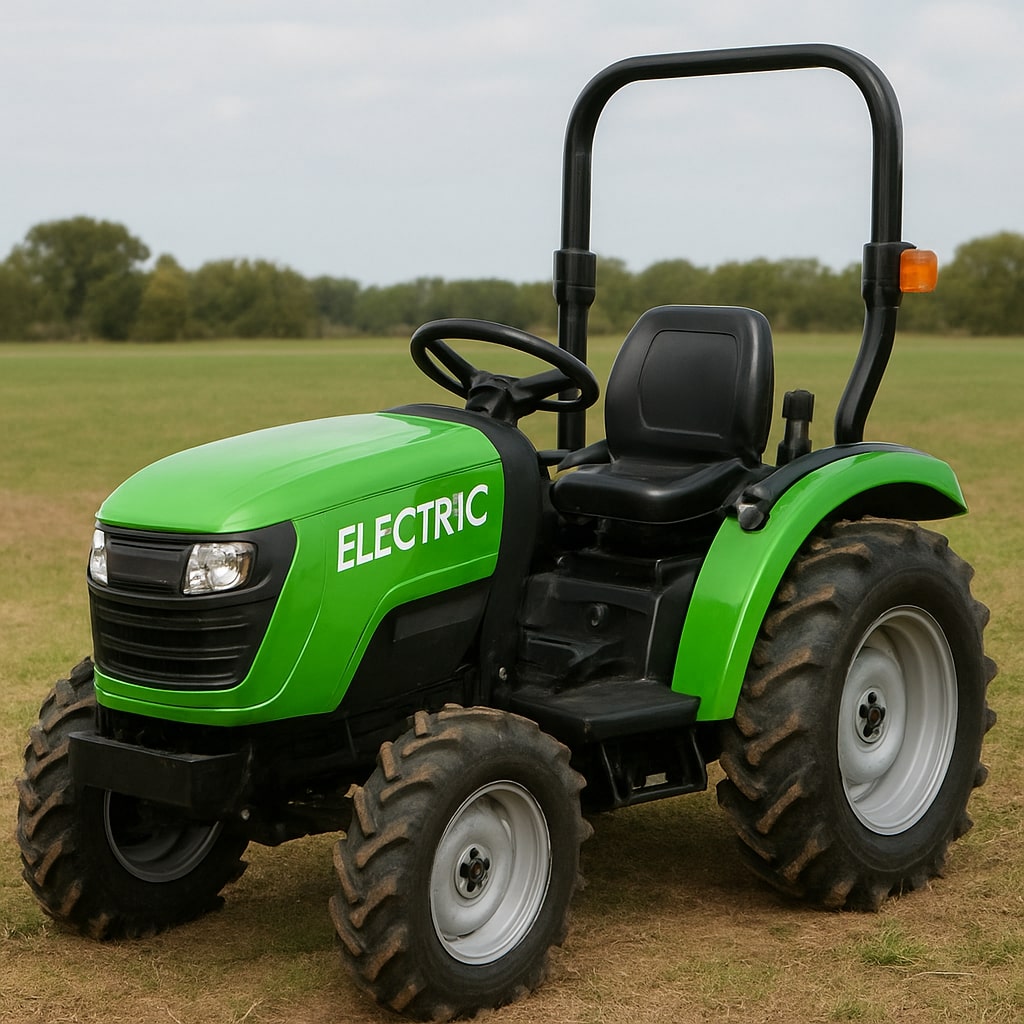What if farming in India felt lighter, cleaner, and more welcoming to women? Women-Friendly Electric Tractor That shift is starting in Raipur, where Chhattisgarh has kicked off a women-friendly electric tractor pilot at IGKV in October 2025. It is part of the state’s Green Farming Initiative, and it puts simple, low-noise, low-emission tech in the hands of farmers who need it most.
Table of Contents
The idea is clear, make agriculture more inclusive and sustainable. Electric tractors cut fuel costs and emissions, and easier controls reduce strain on operators. When machines fit the user, more women can take the wheel with confidence.
This pilot runs at the Swami Vivekanand College of Agricultural Engineering and Technology, a part of IGKV. Backed by state agencies and research partners, it tests an electric tractor model in real farm work, from tilling to hauling. Short trials can still answer the big questions, how it performs, what it saves, and how it feels to use.
Here is what you will find next, a quick background on why Chhattisgarh chose this path, the key features that make the tractor women-friendly, the benefits for cost, health, and productivity, and the plan to scale if the data looks strong. If you care about clean farming and fair access to tools, you will want to see what comes out of Raipur.
The Roots of Chhattisgarh’s Green Farming Initiative
Chhattisgarh is often called the Rice Bowl of India, and for good reason. Farming supports over 70% of the state’s population, shapes village life, and powers local markets. Heavy paddy focus brought gains, but it also strained water, soil, and incomes when weather turned harsh. The Green Farming Initiative grew from this reality, blending climate-smart choices with practical tools that farmers, especially women, can use every day.
A Farm Economy Ready for a Shift Women-Friendly Electric Tractor
Rice is central to identity and income, yet risk has climbed with erratic rain and input costs. Policymakers and researchers called for a steady pivot. Workshops on climate resilience highlighted the dominance of paddy and the need to balance it with hardy crops and better resource use. For context, see these notes on paddy-led risks and adaptation from Cornell’s Tata-Cornell Institute: Key takeaways on climate-resilient agriculture in Chhattisgarh.
Farmers already know the stakes. A bad monsoon can undo a season. A smarter system spreads risk and saves inputs without cutting yields over time.
What the State Is Doing Differently
The initiative builds on programs that reward sustainable choices and reduce waste. The focus is simple, protect soil, save water, and lift incomes.
- Crop diversification: Millets, pulses, and oilseeds reduce water use and stabilize earnings.
- Organic and natural farming: Lower chemical load and better soil life over seasons.
- Water efficiency: Drip, sprinkler, and farm ponds to stretch each liter.
- Agroforestry and IPM: Trees and beneficial insects buffer weather and pests.
- Better seeds and data: Local varieties, weather alerts, and soil advice guide decisions.
Chhattisgarh’s deep rice heritage backs this shift. The state is known for thousands of native rice varieties, a resource for future-proof farming. For a quick background on sustainable practices and rice diversity, see this overview from NABARD: Sustainable Agriculture Practices in the State.
Why Women-Friendly Mechanization Matters
Many women lead farm work yet face barriers with heavy, high-vibration machines. Long hours with tough controls strain backs, wrists, and shoulders. Access and training also lag. The Green Farming Initiative tackles this head on by promoting tools that are lighter, quieter, and easier to handle.
The women-friendly electric tractor pilot at IGKV tests what matters on real fields, low noise, less maintenance, and simple controls. When machines fit the operator, more women can drive, manage tasks, and earn more. That means better timing for sowing and weeding, fewer injuries, and higher confidence. It is a step toward fair access to tools in a state where farming is both a livelihood and a way of life.
What Makes This Electric Tractor Perfect for Women Farmers
This pilot is not just about clean power. It is about fit, feel, and everyday ease. The IGKV team in Raipur is testing how a compact, battery-powered tractor performs in real farm tasks, then recording comfort, load handling, and operator feedback. As reported, the pilot evaluates the CSIR-PRIMA ET 11 in field and haulage work, with a special focus on women operators in Chhattisgarh’s small and medium farms. See the update here: Chhattisgarh launches women-friendly e-tractor pilot at IGKV.
Lightweight and User-Friendly Controls
Traditional diesel tractors can feel heavy and jumpy. This electric unit trims weight and smooths out operation, so more women can steer, reverse, and hitch implements without strain.
- Lighter chassis: Easier starts on soft soil, simpler turns in tight plots, and less arm fatigue during long passes.
- Intuitive dashboard: Clear icons, digital readouts, and simple drive modes reduce guesswork for new operators.
- Smooth throttle: Instant torque without clutch juggling helps with precise maneuvers at low speeds.
- Ergonomic layout: A low step-in height, adjustable seat, and reachable levers support better posture and grip.
In short, it feels closer to driving a compact utility vehicle than a bulky diesel. That matters when you are raking, spraying, or hauling for hours.
Eco-Friendly Power and Low Maintenance
The battery system cuts tailpipe emissions to zero on the farm, which helps air quality and health. It also replaces diesel and frequent oil changes with simple charging and periodic checks.
- Lower running costs: Electricity costs less per hour than diesel in most settings, and there are fewer consumables.
- Fewer moving parts: No engine oil, filters, or complex fuel systems means less downtime and easier upkeep.
- Quiet operation: Low noise reduces stress and allows better communication during group tasks.
- Right-sized capacity: Designed for small to medium plots common in Chhattisgarh, so you get practical range without unnecessary bulk.
At IGKV, instructors are logging charge times, field hours, and operator notes to fine-tune training and support. You can track the project kickoff through CSIR-CMERI’s update here: Flag-off Ceremony for Electric Tractor Pilot Project in Chhattisgarh.
How the Pilot Boosts Inclusivity and Sustainability in Agriculture
This pilot is changing who gets to drive progress on the farm. By pairing clean power with easier operation, it opens real options for women, saves money for families, and cuts pollution in busy ag blocks. Early signals from Raipur suggest momentum, not just a moment, for Chhattisgarh’s climate-smart goals.
More Women at the Wheel
Access is the first win. With simpler handling and quieter operation, more women feel ready to take charge of fieldwork and hauling. That means better timing for sowing and weeding, fewer delays when help is short, and more control over daily decisions.
- Confidence leads to income: When women operate machines, they manage schedules and negotiate services, not just assist.
- Safer, less tiring shifts: Lower vibration and noise reduce fatigue, so workdays feel manageable.
Cleaner Fields, Healthier Villages
Replacing diesel with electric power cuts tailpipe emissions on the farm. That supports cleaner air and safer breathing around homes, schools, and markets near fields. It also fits the state’s push for climate-smart farming and reduced input waste. For context on the pilot’s green focus, see the launch coverage from Raipur: Chhattisgarh launches women-friendly e-tractor pilot at IGKV.
Productivity Gains on Real Tasks
Quiet power helps teams communicate during group work. Faster turnarounds on tilling, transport, and spraying keep operations on schedule. Instructors report smoother task completion and better time use during initial field days.
- Fewer stoppages: Less maintenance and simpler checks mean more hours in the field.
- Reliable starts: Consistent torque supports precision at low speeds.
Lower Costs, Smarter Investments
Electricity typically costs less per hour than diesel, and upkeep is lighter. Families can redirect savings to seeds, irrigation, or storage. Over a season, lower running costs support steadier margins and reduce risk from fuel price spikes.
What Early Feedback Says and What Comes Next
IGKV’s October launch drew strong interest and quick sign-ups for training. Early notes point to easy starts, better comfort, and reduced noise in mixed-crop plots. Teams flagged charging access as a pain point, but partners are mapping school or FPO charging hubs to close gaps. See a snapshot from the flag-off at IGKV, Raipur: CSIR-CMERI update on the pilot kickoff.
If field data on costs, uptime, and operator comfort holds, the state plans to expand units to more blocks and integrate on-farm training. That would push wider adoption, align with diversification efforts, and bring inclusive mechanization into everyday farm life across Chhattisgarh.
Looking Ahead: Scaling Up Green Tech for India’s Farmers
IGKV has the wheels turning. Field teams are logging hours on tillage, transport, and spraying. Early feedback points to easier starts, smoother handling, and quieter shifts. Women trainees are signing up fast, and instructors report strong confidence with basic tasks. The pilot is doing what it should, gather proof that clean, simple machines can carry real farm work. For context on the launch, see the Raipur coverage here, Chhattisgarh launches women-friendly e-tractor pilot at IGKV.
Where the Pilot Stands Now
The test beds at IGKV are busy with daily runs. Teams are tracking charge cycles, uptime, and operator comfort with standard implements. The support group is mapping village charging points and FPO hubs to fix access gaps. Public updates continue to come through project partners, including CSIR-CMERI, which flagged the kickoff and training focus, Flag-off Ceremony for Electric Tractor Pilot Project in Chhattisgarh.
- What users like: Low noise, tight turning, and light controls.
- What needs work: Shared chargers and night-time power access in remote blocks.
What Statewide Scale Could Deliver
The state plans to move units into more rural clusters in phases. Priority goes to service centers linked with FPOs, women SHGs, and ag schools. The goal is clear, reduce fuel bills, improve air quality near homes, and bring more women into paid tractor work.
- Inclusive jobs: More women operators, trainers, and service techs.
- Cleaner fields: Less smoke near schools and markets.
- Lower costs: Predictable power bills instead of diesel spikes.
How You Can Help Push This Forward
You can speed up adoption with small steps that stack up.
- Ask your FPO or SHG to join pooled tractor services.
- Host a field demo day in your village and invite nearby groups.
- Share charging space at schools or panchayat buildings.
- Track your costs and hours, then share data with local officers.
- If you sell inputs, offer a charge-and-implement bundle for sowing season.
Want to explore models and features in the wider market for context? This quick overview helps compare specs and use cases, Electric Tractors in India 2025: Top Models, Features.
Conclusion
Chhattisgarh’s women-friendl electric tractor pilot shows how clean tools and smart design can open doors for women, cut costs, and reduce farm pollution. It proves that inclusive mechanization is not a promise, it is a practical path for everyday work.
The impact can spread fast. With training, shared charging, and FPO support, this model can shift incomes, improve health, and bring more women into skilled roles across the state.
If this inspired you, learn more about green farming in your district, join or support a local demo, and share this post with a friend or farmer group. Small steps add up when people move together.







